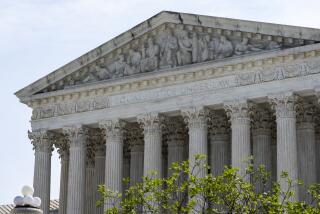Truth Bows to Fiction in Debate Over School Prayer : Public campuses are not at all devoid of religion, as some argue. A proposed constitutional amendment covering acts of worship could breach the rights of religious minorities.
- Share via
Repeat half-truths enough and they become truths.
Some members of Congress have applied this propagandists’ credo to religion in public education. According to these lawmakers, prayer, God, religion and morality are missing from public education and account for America’s moral decline.
This version of reality seems to be shared by many who believe that the nails were positioned on religion’s coffin with the 1962 U.S. Supreme Court decision banning school-organized prayer and nailed in place with the 1985 decision that banned state-sanctioned moments of silence.
Yet nothing could be further from the truth. If anything, religion has made a comeback on public school campuses since the 1980s. The Judeo-Christian God thrives on campuses today, perhaps to the detriment of those who do not belong to the Judeo-Christian tradition.
Congress and the courts have already allowed enough religion to find its way onto public school campuses without adding prayer through a constitutional amendment. Walk onto almost any high school campus during lunch hour and you will find clubs meeting, including religious-oriented ones.
My school’s Falcon Christian Fellowship club has more than 75 members. They hear speakers, pray and sing praises, and no one tells them not to.
Walk into my world-history class. California guidelines ask that students “review the moral and ethical principals of Judaism and Christianity” when they learn about the growth of democracy. So we read and discuss portions from the Old and New Testaments.
Walk into my sophomore English class when we are discussing the language used in John Steinbeck’s “Of Mice and Men.” Listen to the students debate whether such a book should even be read when its characters take God’s name in vain. “I can understand why someone who is a Christian might be uncomfortable reading this book,” a student says.
Walk onto campus and see the classroom doors decorated for the holidays. Listen to the carolers roaming the halls, singing songs of Christ’s birth. Hear the wishes for a merry Christmas.
I doubt that Crescenta Valley High School is some kind of city upon a hill. I doubt that schools in other parts of the Valley are kicking their Christian students out the door.
Yet that seems to be the perception.
What many seem to forget is that there are pupils happily outside the Judeo-Christian tradition on school campuses.
Last year a student who is Hindu wrote that she did not think it right for some teachers to display their Christianity so plainly in class, suggesting that Christianity was the preferred religion. This year a student who practices a Native American religion has reminded our English class that native religions were the main ones on this continent until Europeans virtually annihilated them.
In one class, students have written about why they are agnostics and atheists. Do we make room for nonbelievers? I think the First Amendment says we must, but sometimes I wonder if we truly care about protecting the rights of the minority from the abuses of the majority.
In 1990 the Supreme Court held that public schools must allow religious groups to meet if they allow other non-curricular clubs to meet. Federal law mandates that schools allow religious clubs to meet on public school campuses. Many school districts allow elementary school children to leave campus during the school day for religious education. California guidelines on history require teachers to teach about the major world religions.
Yet some members of Congress are backing a constitutional amendment to put prayer back into schools.
In October, Rep. Carlos J. Moorhead (R-Glendale) joined 41 other members to support Rep. Ernest Istook Jr.’s (R-Okla.) draft of an amendment that would give public schools a legal means for re-establishing voluntary organized school prayer or moments of silence. It reads:
“Nothing in this Constitution shall be construed to prohibit individual or group prayer in public schools or other public institutions. No person shall be required by the United States or by any State to participate in prayer. Neither the United States nor any State shall compose the words of any prayer to be said in public schools.”
While this may sound innocuous enough, what is to stop a school’s student body government from writing a prayer to be read over the intercom? It would not be a government-written prayer, but wouldn’t the school be saying that this is our preferred prayer, this religion is our preferred religion? Wouldn’t the school be saying that if you don’t believe in any religion, you are not welcomed in society?
A constitutional amendment would be redundant if it merely ensured students’ unfettered right to prayer. The First Amendment already guarantees this right.
Lawmakers may vote to “restore” religion in the classroom because they have wrongly convinced many Americans that it has been thrown out.
Truth doesn’t seem to be worth much anymore; perception is all that matters.
More to Read
Sign up for Essential California
The most important California stories and recommendations in your inbox every morning.
You may occasionally receive promotional content from the Los Angeles Times.










